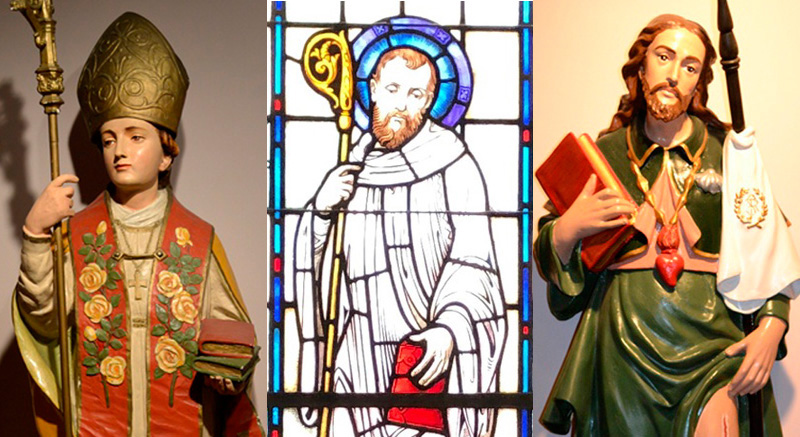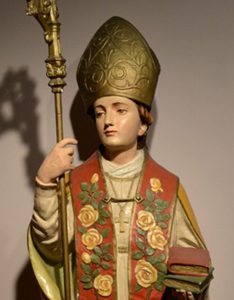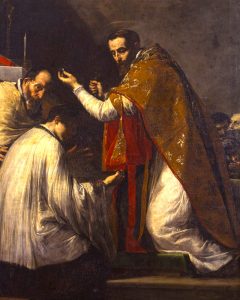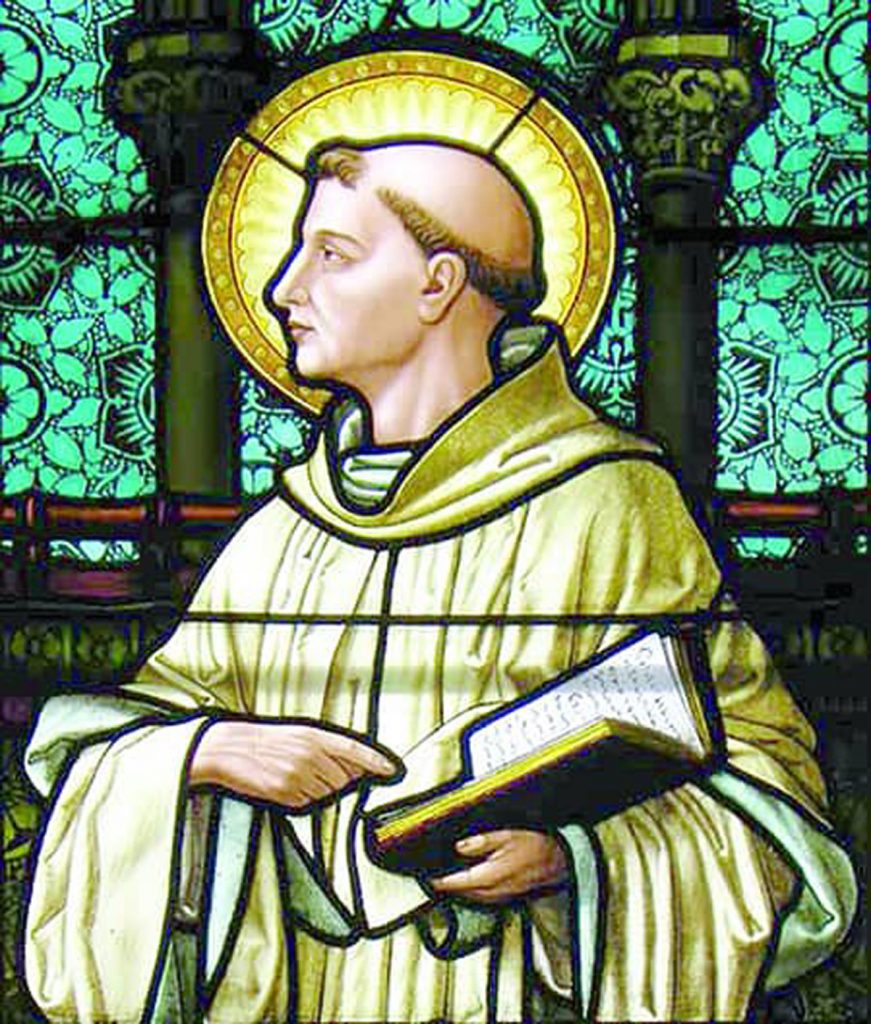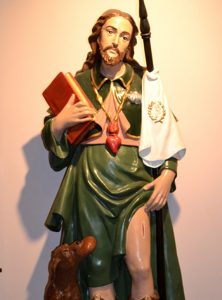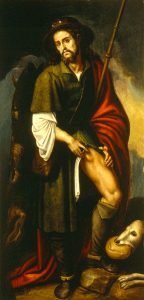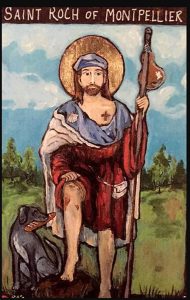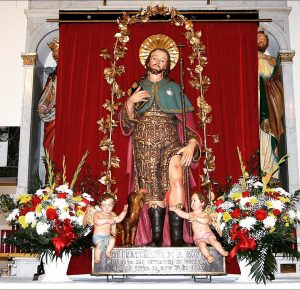Our church has a statue and a window of St. Rocco, a statue of St. Donato, and a window of St. Bernard of Clairvaux. The feasts of these men are all during the month of August. For more on the saints, check out our Saint of the Day feature
St. Donato: The Shattered Chalice & the Strength of Faith
St. Donato of Arezzo is the patron saint of Arezzo, and considered a bishop of the city.
A passio of his life was written by another bishop of Arezzo, Severinus. He called Donato a martyr, though Donato is described as a bishop and confessor of the faith in ancient sources rather than as a martyr. According to tradition, Donato was martyred on Aug. 7, 362 during the reign of Julian the Apostate.
According to Severinus’ account, as a child Donato came to Rome with his family from Nicomedia. Orphaned, in the early account, during a persecution and named by the bishop of Arezzo, Donato was educated by a Christian priest named Pimenio; his friend and companion in these religious studies was a boy named Julian, who would later become Emperor Julian the Apostate.
St. Peter Damian later wrote in his Sermones that “in the field of the Lord two sprigs, Donato and Julian, grow together, but one will become a cedar of Paradise, the other coal for the eternal flames of Hell.”
On Feb. 4, 362, Julian promulgated an edict to guarantee freedom of religion. This edict proclaimed that all the religions were equal before the law. Christian chroniclers considered that it had as its purpose the restoration of paganism at the expense of Christianity. Catholic tradition states that Julian also persecuted individual Christians, and that Donato’s parents, as well as his teacher Pimenio, died during these persecutions.
Donato escaped to Arezzo and worked with a monk named Hilarian to preach the Christian faith, as well as perform penances and miracles. Donato brought back to life a woman named Euphrosina; he fought and slew a dragon who had poisoned the local well; he gave sight back to a blind woman named Syriana; and he exorcised a demon that had been tormenting Asterius, the son of the Roman prefect of Arezzo.
Donato was ordained a deacon and priest by St. Satyrus of Arezzo, bishop of that city, and continued to preach in the city and in the surrounding region. At the death of Satyrus, Donato was appointed a bishop by Pope Julius I.
During a celebration of Mass, at the moment of the giving of communion, in which a glass chalice was being administered, some pagans entered the church and shattered the chalice in question. Donato, after intense prayer, collected all of the fragments and joined them together. There was a piece missing from the bottom of the cup; miraculously, however, nothing spilled from the cup. Astounded, seventy-nine pagans converted to Christianity.
A month after this episode, the prefect of Arezzo, Quadratian, arrested Hilarian the Monk and Donato. Hilarian was martyred on July 16, 362 and Donato was beheaded on August 7 at Arezzo.
In this painting “La Leyenda Dorada” (The Golden Legend) Ribera depicts how the deacon during Mass was pushed so violently by the pagans that the chalice fell and broke into a thousand pieces. Donato picked up the pieces and prayed over them until they miraculously reformed the chalice. Ribera paints the impressive figure of Donato dominating the composition holding in his hands the pieces of the chalice. Another priest looks fervently upon the entire scene, along with others fervently praying.
St. Donato’s feast day is Aug. 7.
During these days of pandemic, the many “shattered chalices” of our lives can be brought to prayer and perhaps we can hold them again with tenderness and understand the sacredness of all things.
Prayer to St. Donato for our church and her leaders
O St. Donato, bishop and martyr, you brought people healing and restored them to life. You cared for the people in your city and provided holy leadership as their bishop. We ask your intercession for our bishop ( Name ), for all bishops, cardinals, and for our Pope, the Bishop of Rome, that together they will lead our church and our entire world toward health and holiness. May they have wisdom and work toward unity. May they be ready to surrender their selfish desires and politics so that the church may be a force of love in our world, and inspire peace in all nations. Amen.
St. Bernard of Clairvaux: The Power of Diplomacy & Prayer
Man of the century! Woman of the century!
You see such terms applied to so many today — “golfer of the century,” “composer of the century,” “right tackle of the century”— that the line no longer has any punch.
But Western Europe’s “man of the 12th century,” without doubt or controversy, had to be Bernard of Clairvaux. Adviser of popes, preacher of the Second Crusade, defender of the faith, healer of a schism, reformer of a monastic order, scripture scholar, theologian and eloquent preacher: any one of these titles would distinguish an ordinary man.
Yet Bernard was all of these — and he still retained a burning desire to return to the hidden monastic life of his younger days. 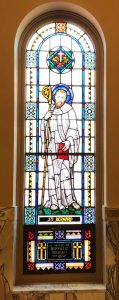 In the year 1111, at the age of 20, Bernard left his home to join the monastic community of Citeaux. His five brothers, two uncles and some 30 young friends followed him into the monastery. Within four years, a dying community had recovered enough vitality to establish a new house in the nearby valley of Wormwoods, with Bernard as abbot. The zealous young man was quite demanding, though more on himself than others. A slight breakdown of health taught him to be more patient and understanding. The valley was soon renamed Clairvaux, the valley of light. His ability as arbitrator, peace maker, diplomat and counselor became widely known. More and more he was lured away from the monastery to settle long-standing disputes within the church. On several of these occasions, he apparently stepped on some sensitive toes in Rome though he was completely dedicated to the primacy of the Roman See. To one letter of warning from Rome, he replied that the good fathers in Rome had enough to do to keep the Church in one piece. If any matters arose that warranted their interest, he would be the first to let them know.
In the year 1111, at the age of 20, Bernard left his home to join the monastic community of Citeaux. His five brothers, two uncles and some 30 young friends followed him into the monastery. Within four years, a dying community had recovered enough vitality to establish a new house in the nearby valley of Wormwoods, with Bernard as abbot. The zealous young man was quite demanding, though more on himself than others. A slight breakdown of health taught him to be more patient and understanding. The valley was soon renamed Clairvaux, the valley of light. His ability as arbitrator, peace maker, diplomat and counselor became widely known. More and more he was lured away from the monastery to settle long-standing disputes within the church. On several of these occasions, he apparently stepped on some sensitive toes in Rome though he was completely dedicated to the primacy of the Roman See. To one letter of warning from Rome, he replied that the good fathers in Rome had enough to do to keep the Church in one piece. If any matters arose that warranted their interest, he would be the first to let them know.
Shortly thereafter it was Bernard who intervened in a full-blown schism and settled it in favor of the Roman pontiff against the antipope.
The Holy See prevailed on Bernard to preach the Second Crusade throughout Europe. His eloquence was so overwhelming that a great army was assembled and the success of the crusade seemed assured. The ideals of the men and their leaders, however, were not those of Abbot Bernard, and the project ended as a complete military and moral disaster.
Bernard felt responsible in some way for the degenerative effects of the crusade. This heavy burden possibly hastened his death, which came Aug. 20, 1153. Though his entire life was successfully spent in teaching and in dedication to the church and her teachings, he was entirely saddened by this last endeavor which he was unable to control.
Bernard’s life in the church was more active than we can imagine possible today. His efforts produced far-reaching results. But he knew that they would have availed little without the many hours of prayer and contemplation that brought him strength and heavenly direction.
His life was characterized by a deep devotion to the Blessed Mother. His sermons and books about Mary still are the standard of Marian theology. We can pray to Bernard that we may have the words to bring others to understand the Church, even in these days when her failings are so evident.We can pray to Bernard for perseverance, that we may remain strong in our faith and in our ministry; especially in times of disappointment or in times when we do not feel the support of others within the Church.
St. Rocco and the Healing Sign of the Cross
St. Rocco (1340–1378) was a confessor whose death is commemorated Aug. 16 and he is specially invoked against the plague. He is a patron saint of dogs, invalids, of falsely accused people, bachelors, and several other things.
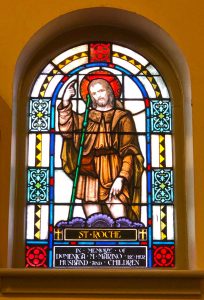 St. Rocco is venerated in the Roman Catholic Church as the protector against the plague and all contagious diseases. St. Rocco was born in 1340 at Montpellier, France, the son of the noble governor of that city. Even his birth was accounted a miracle, for his noble mother had been barren until she prayed to the Virgin Mary. Miraculously marked from birth with a red cross on his breast that grew as he did, early in his life, he showed great devotion to God and the Blessed Mother. At the death of his parents, when he was 20, he distributed all his wealth among the poor like Francis of Assisi — and took a vow of poverty. He left Montpellier and traveled to Rome as a beggar pilgrim. Coming into Italy during an epidemic of plague, he was very diligent in tending the sick in the public hospitals, and effected many miraculous cures by prayer with the sign of the cross and the touch of his hand. Ministering at Piacenza he finally fell ill. He was expelled from the town and withdrew into the forest, where he made himself a hut of boughs and leaves, which was miraculously supplied with water by a spring that arose in the place; he would have perished but, miraculously a nobleman’s dog who refused to eat supplied him with bread and licked his wounds, healing them.
St. Rocco is venerated in the Roman Catholic Church as the protector against the plague and all contagious diseases. St. Rocco was born in 1340 at Montpellier, France, the son of the noble governor of that city. Even his birth was accounted a miracle, for his noble mother had been barren until she prayed to the Virgin Mary. Miraculously marked from birth with a red cross on his breast that grew as he did, early in his life, he showed great devotion to God and the Blessed Mother. At the death of his parents, when he was 20, he distributed all his wealth among the poor like Francis of Assisi — and took a vow of poverty. He left Montpellier and traveled to Rome as a beggar pilgrim. Coming into Italy during an epidemic of plague, he was very diligent in tending the sick in the public hospitals, and effected many miraculous cures by prayer with the sign of the cross and the touch of his hand. Ministering at Piacenza he finally fell ill. He was expelled from the town and withdrew into the forest, where he made himself a hut of boughs and leaves, which was miraculously supplied with water by a spring that arose in the place; he would have perished but, miraculously a nobleman’s dog who refused to eat supplied him with bread and licked his wounds, healing them.
The nobleman took pity on Rocco and brought him to his castle where he was fully cured.
St. Rocco, by Francesco Ribalta (1625) Museo de Bellas Artes, Valencia.
